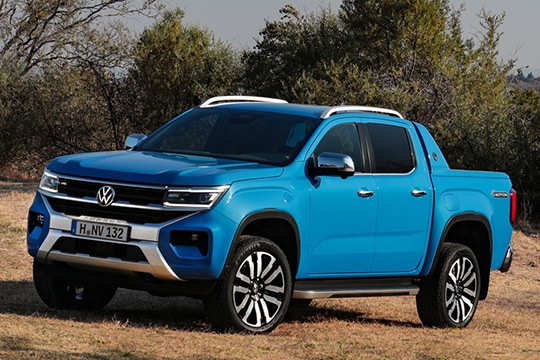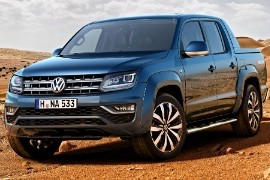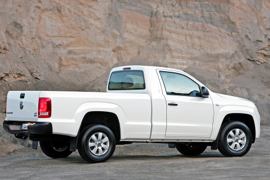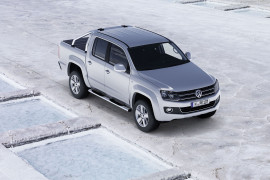VOLKSWAGEN Amarok Models/Series Timeline, Specifications & Photos
First production year: 2009
Engines: Diesel, Gasoline
Body style: Truck
The Volkswagen Amarok came to fruition in 2010 as a result of extensive work that started back in 2005. As a mid-size pickup truck, it fulfills the need for ample cargo space, transporting goods with a very high volume while satisfying the need for a comfortable car in day-to-day life.
While being a standard for quality, the new Amarok succeeds in filling the boots of the last generation regarding practicability, reliability, and versatility. The new model encapsulates all the off-road capabilities of its predecessor in a way more impressive package, using up-to-date materials and technology to provide its users with a well-rounded experience.
The interior is marked by the leather inserts on the instrument panel and on the door trim surfaces and by the digital cockpit, which optionally can have up to 12 inches. A high-end Harman Kardon audio system accompanies all the delicate touches.
The model is based on the Ford T6 platform and shares multiple features with the Ford Ranger and the Ford Everest, making it quite a unique Volkswagen. It comes in four variants: Life, Style, PanAmericana and Aventura. The options vary from a standard-equipped truck to a premium one ready to take on tough off-road challenges.
The customizability extends even to the engine and transmission, and the car can have a rear-wheel drive or all-wheel drive complemented by an engine ranging from an inline four 2.0 L to a V6 3.0 L capable of 236 horsepower. The Amarok also has an impressive towing capacity of 7000 lbs, made possible by the automatic transmission, which enhances the engine's power in the best way possible.
From the standpoint of cargo capacity, the loading area can impressively fit a Euro pallet loaded sideways between the wheel arches and has sturdy eyelets that can help fix it. Volkswagen offers the option of a hard top or a roll cover, marketed as accessories meant to help you accommodate different types of cargo in the back of your truck. Also, the roof has a load capacity of 700 pounds, more than enough to pitch a tent or have some extra storage while camped.
Regarding camping, the new model aspires to handle well all the off-road encounters that may interfere with a smooth and fun drive. For instance, the fording depth was extended by 11 inches, totaling a staggering 31 inches. This feature may help you get to previously unreachable spots where you can set your camp deep into the wilderness.
The charm of the Amarok is that while it can perform outstandingly on various terrains, it can also be the smooth ride you enjoy on your daily commute to work, making you feel pleased when you spend time near the truck or in it, while you're stuck in traffic.
VOLKSWAGEN Amarok 2.0L TDI 4MOTION 10AT AWD (205 HP)
VOLKSWAGEN Amarok 2.0L TDI 4MOTION 10AT AWD (209 HP)
VOLKSWAGEN Amarok 2.0L TDI 4MOTION 6MT AWD (170 HP)
VOLKSWAGEN Amarok 2.0L TDI 4MOTION 6MT AWD (205 HP)
VOLKSWAGEN Amarok 2.0L TDI 5MT RWD (150 HP)
When Volkswagen introduced the Amarok in 2010, it didn't know too much about this segment, but most of the model's problems were solved in 2016 when the carmaker introduced a facelift for this pickup.
Thus, the idea of a lifestyle pickup started to emerge on the market. Apart from a few Japanese brands, Volkswagen Commercial Vehicle developed the Amarok, which was exactly that: a pickup that was better at transporting light loads and five people than heavy loads and just two.
Volkswagen refreshed the Amarok in 2016 and made it look more like an SUV than a utility vehicle. Thus, the front fascia received a new pair of headlights with integrated LED daytime running lights. The grille was also revised and now resembled the ones fitted on the likes of Tiguan and Touareg. Its profile still kept the same flared, angular wheel arches. As an option, the automaker offered side steps and a roll-bar in the bed area.
Inside, there was more of an SUV feel than a utility vehicle. The dashboard was covered with softer materials and sported a new infotainment system atop the center stack. Moreover, the instrument cluster featured large dials and a TFT display between the tachometer and speedometer that showed various data from the onboard computer. Depending on the options, the Amarok could have been fitted with fabric or leather upholstery.
But the most significant change was under the hood, where Volkswagen installed a 3.0-liter turbo-diesel V6 engine, which was available with a few power options. Another unusual decision was for the transmission. While the manual versions were fitted with a high and low transfer case, the eight-speed automatic was an all-wheel drive affair with no reduction gear.
VOLKSWAGEN Amarok Double Cab 3.0L V6 4MOTION 6MT AWD (163 HP)
VOLKSWAGEN Amarok Double Cab 3.0L V6 4MOTION 8AT AWD (258 HP)
VOLKSWAGEN Amarok Double Cab 3.0L V6 6MT (163 HP)
VOLKSWAGEN Amarok Double Cab 3.0L V6 TDI 4MOTION 8AT (204 HP)
VOLKSWAGEN Amarok Double Cab 3.0L V6 TDI 4MOTION 8AT (224 HP)
In the midst of downsizing, VW took the lead decreasing the engine displacement for the pickup market to just 2.0 liters. Americans have pickups with over three times more displacement engines. This one, though, is different. It is a 2.0-liter bi-turbodiesel unit that offers up to 170 hp.
Unlike its four-door sibling, which was launched in 2011, the Amarok single cab comes with a standard 6-speed manual, but the 8-speed ZF automatic transmission was offered as an option. And that was better since it doesn't need a transfer case or a low-gear ratio. First gear is low enough to haul up to 3000 kg (6613 lbs) and the eighth is overdrive for highway cruising.
The single cab has a 2.2 meter (7.2 ft) long bed, which is good enough for most of the loads. Those who need, can order the single-cab as a chassis-cab and complete the vehicle with other structures instead of a bed. Particular attention was given to the rear suspension, where the customer could have ordered a light-duty or heavy duty leaf-springs. Unlike its 4-door sibling, the single-cab can be ordered only with heavy-duty leaf springs. This allows the vehicle to carry up to 1394 kg (3073 lbs), depending on the model
The base interior is covered in plastic and fabric seats but still has an AC-unit and a basic sound system.
VOLKSWAGEN Amarok Single Cab 2.0L TDI 4MOTION 6MT AWD (140 HP)
VOLKSWAGEN Amarok Single Cab 2.0L TDI 4MOTION 6MT AWD (180 HP)
VOLKSWAGEN Amarok Single Cab 2.0L TDI 6MT RWD (140 HP)
VOLKSWAGEN Amarok Single Cab 2.0L TDI 6MT RWD (180 HP)
VOLKSWAGEN Amarok Single Cab 2.0L TDI BlueMotion 6MT RWD (140 HP)
VOLKSWAGEN Amarok Single Cab 2.0L TDI BlueMotion 6MT RWD (180 HP)
In the quest for the leisure pickup, Volkswagen rolled the dice with the Amarok 2.0-TSI. A vehicle that was far away from their regular lineup vehicles. It was far from the Volkswagen commercial vehicles, as well.
Volkswagen brand had two big divisions: the personal car and the commercial vehicle unit. The Amarok was launched by the latter, with some help from the former, especially with the engines and transmissions. The Amarok was intended to be a pickup for leisure, something like a RAM 1500 or Nissan Frontier.
The car looked tough and strong on its body-on-frame construction. The Amarok brought some amenities in and outside the vehicle. With its strong presence, and longitudinal blades on the grille, it looked like a serious contender on the market.
Inside, there were choices for cloth or leather seats. Simple radios or a complex infotainment unit with navigation system. The top trim levels featured leather upholstery with heated front seats.
The Amarok featured a small, 2.0-liter turbodiesel engine, or a 2.0-TSI engine which was mated either wit a 6-speed manual or an 8 speed automatic, depending on the market. An option for a locking rear differential was offered. The Amarok didn't feature a transfer case with low range, but the lower gears were short enough to move the pickup in off-road or pull a boat out of the water.
VOLKSWAGEN Amarok Double Cab 2.0L BiTDI 4MOTION AWD 6MT (163 HP)
VOLKSWAGEN Amarok Double Cab 2.0L BiTDI 6MT (180 HP)
VOLKSWAGEN Amarok Double Cab 2.0L BiTDI 8AT 4MOTION AWD (180 HP)
VOLKSWAGEN Amarok Double Cab 2.0L BiTDI RWD 6MT (163 HP)
VOLKSWAGEN Amarok Double Cab 2.0L TDI 4MOTION 6MT AWD (120 HP)
VOLKSWAGEN Amarok Double Cab 2.0L TDI 4MOTION 6MT AWD (140 HP)
VOLKSWAGEN Amarok Double Cab 2.0L TDI 6MT RWD (120 HP)
VOLKSWAGEN Amarok Double Cab 2.0L TDI 6MT RWD (140 HP)
VOLKSWAGEN Amarok Double Cab 2.0L TDI Blue Motion RWD 6MT (140 HP)



